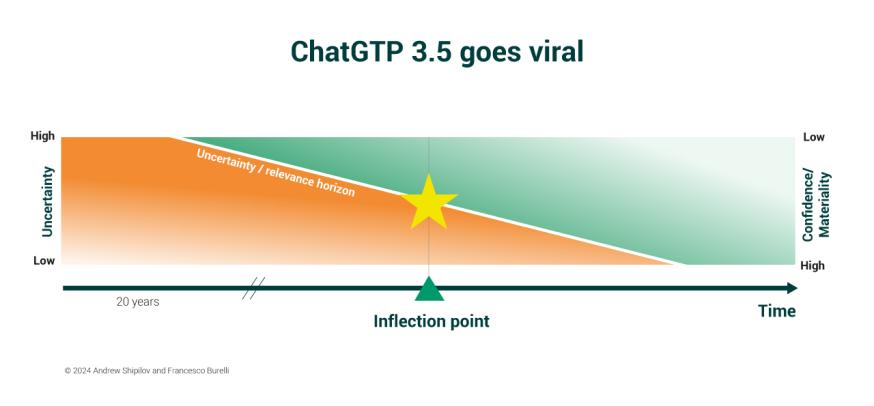
In 2019, few people talked about messenger ribonucleic acid, or what is commonly known as mRNA. But by the fall of 2020, this acronym was all over the news because it enabled quick production of vaccines to fight Covid-19. Similarly, in the summer of 2022, few people knew what Generative AI (GenAI) meant. Yet the launch of ChatGPT in November made everyone aware of this technology’s immense opportunities.
What happened? Between the summer and fall of 2022, Gen AI passed an inflection point. High uncertainty about its performance gave way to increased confidence that the technology would affect businesses in a significant way. We illustrate this trade-off between uncertainty and confidence in a simple figure below.

If your company is working on a new technology that has yet to pass this inflection point, what must happen to get you there?
The evolution of new technologies follows an S-curve. In the beginning, there is a long incubation period during which technological development and use are confined to basic science. This period is characterised by high uncertainty about the technology’s performance and there is virtually no confidence in the emergence of concrete business use cases.
Eventually, there is an inflection point beyond which the performance and use cases of new technologies increase exponentially. At that time, uncertainty about their performance decreases rapidly while the confidence in their applications increases. At the end, the improvements in the technology’s performance decrease and eventually reach a plateau. By then, the technology would either have been well-leveraged or even used by competitors to supplant the incumbent.
Technologies such as mRNA or GenAI have passed that inflection point, whereas others, such as quantum computing, are not there yet. Three simultaneous factors are required to reach the inflection point:
- Public attention: The public must be aware of the technology and what it can do. Performing a web search is the easiest way to track whether the public pays attention to a technology. Interest in GenAI increased following ChatGPT’s launch. Interest in mRNA increased when Covid-19 hit. But public interest in quantum computing has not grown yet.
- Investment: Funds must be spent on boosting the technology’s performance.
- Complements: These comprise products or services that combine with the technology to make it more valuable and augment its performance.
Public attention is necessary so that more entrepreneurs, academics and business people start tinkering with its use cases. While GenAI has created headaches for schoolteachers trying to decipher which essays were written by a student or by a bot, law firms have started to train models on legal texts to lower the costs of hiring paralegal assistants. In Amazon, GenAI now tags products and responds to customer queries for online shopping.
Increased attention to GenAI has attracted investors who are ready to commit billions of dollars to developing new models or the hardware needed to run them. More and more companies are coming up with complementary products and services that use GenAI, such as image generation integration in Adobe or essay writing help in Microsoft Word. Google's Vertex AI Search and Conversation (formerly Gen App Builder) allows users to train Gen AI tools on their companies’ internal documents in order to retrieve internal information and produce knowledge summaries in seconds.
Public attention can also result from external events, such as pandemics. At first, mRNA was a niche technology competing for attention with many other vaccine vector technologies. Covid-19 happened and the public learned about the pros and cons of this technology. Attention attracted investments. At the end of 2019, the market capitalisation of the five companies that focused on mRNA technology was US$15 billion. By August 2021, that number had reached US$300 billion.
The number of complementary technologies for using mRNA increased concurrently. Now it is used as a part of a toolkit for discovering new drugs, antibodies or enzymes. In addition, new use cases and complementary technologies include protein replacement therapy, immunotherapies, gene editing and nanoprinted materials.
Companies ignore complements, and how these could transform established value propositions or enable new ones, at their own peril. Nokia learned the hard way when it developed mobile phones without building a broad content ecosystem around it. By contrast, OpenAI has already created a GPT Store where entrepreneurs can create their own chatbot using OpenAI’s powerful technologies.
Getting there
Quantum computing represents an example of a technology that has not reached an inflection point yet. Quantum uses atoms and subatomic particles, such as electrons or photons, to run calculations beyond the capability of even the most powerful supercomputers. While quantum computing is not expected to supplant conventional computers, at least for the time being, it could become a platform for radically enhanced applications when applied to distributed applications hosted on the cloud.
At the time of this writing, there is no strong public attention to quantum, nor much talk about the development of complements. Nonetheless, companies are investing significant amounts of money to develop the first use cases of this technology due to its potential for business and national security applications.
These three factors can undoubtedly be influenced by technology’s performance. However, even if the technology is high performing, the technology will not pass the inflection point if there is little public attention and if companies won’t invest, resulting in few complements.
System dynamics theory teaches us that in complex systems, individual elements may mutually reinforce each other via feedback loops. In the case of technological transition, more attention may lead to more investment. More investment may then lead to even more attention, which will also make people look for new complements. These feedback loops can then push the technology forward, beyond the inflection point.
So, if you are driving your company’s technology strategy, don’t just look at the road ahead trying to guess when the inflection point will arrive. In addition, look in the rearview mirror for the investments that others have made into this technology. You also need to look sideways to see if there is growing public attention to this technology or emerging complements that you might have missed. This way, you will avoid the blind spots and won’t miss the technology’s inflection point when it looms over the horizon.
Edited by:
Isabelle Laporte-
View Comments
-
Leave a Comment






No comments yet.